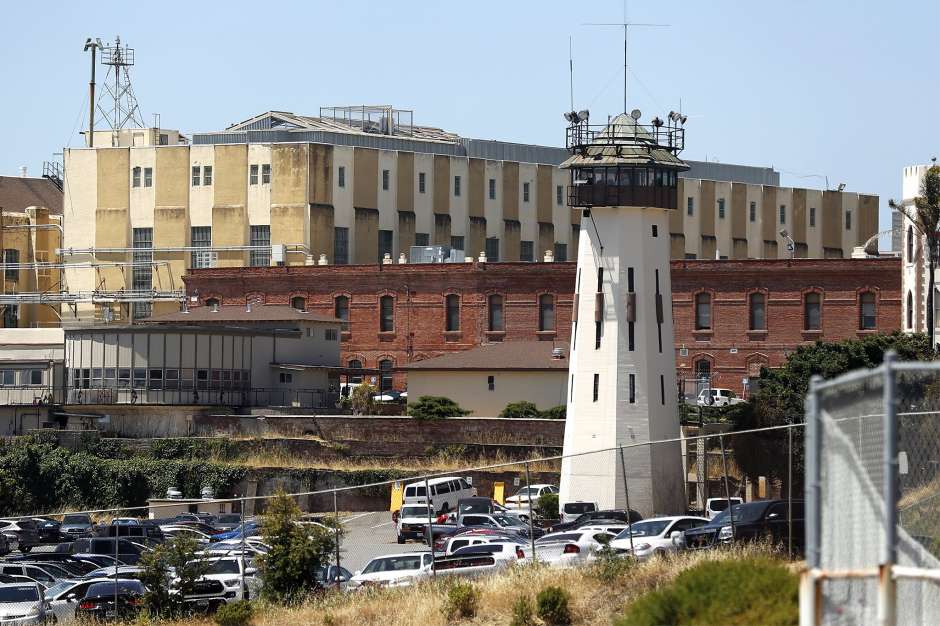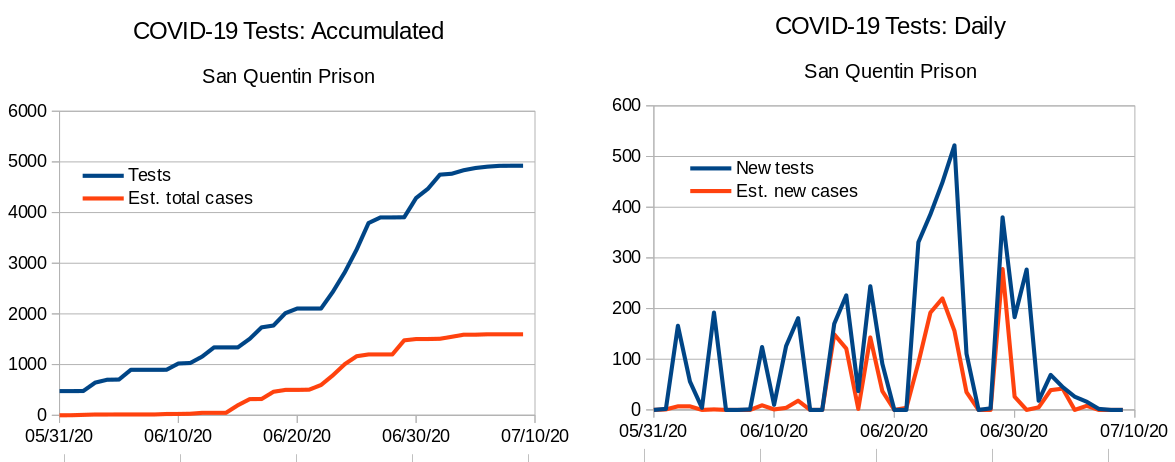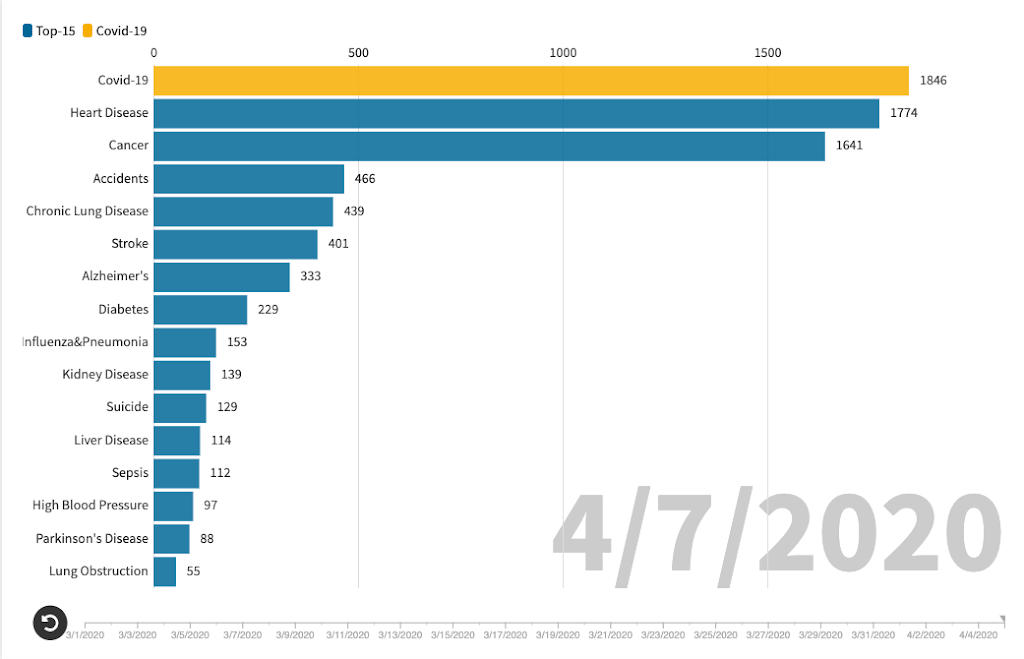CDCR’s plan for releasing 8,000 explained. It will provide essential relief to some incarcerated people and their families, but it is too little, too late, too reactive, and too tailored to public pressure.
Continue readingBREAKING NEWS: Newsom to Release 8,000 People from CA Prisons
The Chron reports:
Gov. Gavin Newsom is set to announce that he will release approximately 8,000 people incarcerated inside California’s prison system, in a move that comes amid devastating coronavirus outbreaks at several facilities and pressure from lawmakers and advocates.
Prisoner attorney Donald Specter on Friday said the announcement is expected early this afternoon. Specter, who is the executive director of the Prison Law Office, the organization that represents prisoners in a long-running lawsuit alleging inadequate medical services, said the governor’s office advised of the details.
“We certainly appreciate the effort from the administration to reduce the prison population,” Specter said. “We still remain concerned that there’s not enough space, especially in places like Vacaville and Folsom to house people safely if the virus gets into those institutions.”
Across state prisons, 2,286 inmates were confirmed to have active cases of the virus and 31 had died as of Friday morning, according to California Department of Corrections and Rehabilitation. Staffers with active cases of the virus totaled 719.
Specter said the releases will come on a rolling basis, and they’ll include both people who were scheduled to be freed soon as well as people at high risk for serious complications if they contract the virus.
Those bound for releases include about 700 people from high-risk prisons like San Quentin, Folsom and the California Medical Facility, Specter said, as well as people who are in hospice and appropriate for release. State prisons have about 6,500 people who are high risk medically for COVID-19 and low risk for recidivism, he said, “and they’re going to start releasing some of them.”
The move will expedite the governor’s review for people who were granted parole, which can traditionally take about six months, Specter said.
Prison officials announced Thursday night that they would provide 12 weeks of credit to every inmate eligible for release who had not been found guilty of a serious rule violation between March 1 and July 5. The policy, adopted because prisons have shut down their credit-earning programs during pandemic, could benefit as many 108,000 people.
With the reduced sentences, about 3,100 inmates would reach their earlier possible release date, officials estimated, with those releases set to begin Aug. 1.
Too few and too late, but it’s a start. The advocates, activists, and elected officials are making a difference. We must press on to stop this human rights crime.
Testing, Testing: Why COVID-19 Testing Is a Crucial Element of Curbing Prison Pandemic
CDCR seem to have taken a page out of Trump’s pandemic prevention book: They slowed down testing in San Quentin, the epicenter of the prison pandemic. We found a big push in testing in late June shortly after the San Quentin disaster broke into mainstream media. Indeed, a high percentage of the tests came back positive. Even though cases were still rising, around July 3, testing came to a grinding halt–and the few tests that were still coming in were coming in positive. The correlation we found between cumulative testing and cumulative cases is 0.99. The correlation between new testing and new cases is 0.7. In other words: The more people you test, the more people come out positive. If you’re seeing abatement in the numbers of infected people, it does not necessarily mean fewer infected people. It could mean, and actually does mean, less testing.
Continue reading#StopSanQuentinOutbreak Press Conference
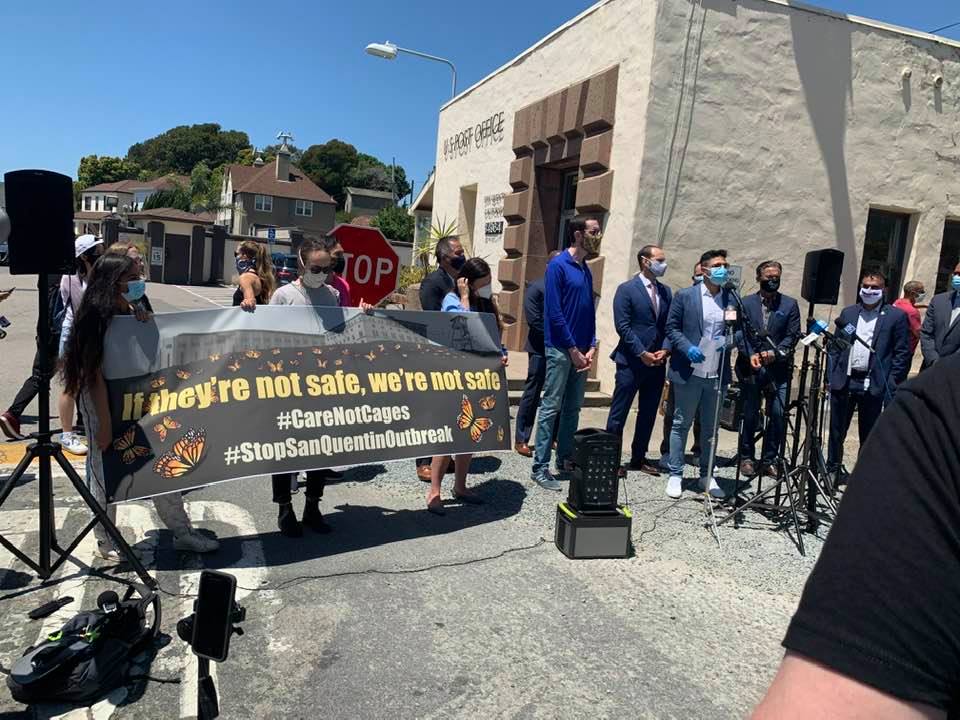
Yesterday, on July 9, we held a press conference at San Quentin to draw attention to the conditions inside the prison. We invited Gov. Newsom to participate, but he did not attend. His absence was glaring, as one of the demands of the protesters is that he at least make the effort to visit the prison and see the conditions with his own eyes.
You can read about the press conference in the Guardian, the Chron, and the ABC News website. It was incredibly moving to hear from mothers and spouses of people on the inside about the desperation of their loved ones. James King, state campaigner for the Ella Baker Center who is formerly incarcerated in San Quentin, shared a letter from a friend of his currently behind bars that truly conveyed the horror of dealing with this pandemic. Shawanda Scott spoke of the loving home she has waiting for her son. These testimonies undercut the myth that no one is waiting for those afflicted on the outside, and that, as James said, “the minute they are released… tens of thousands of families will be here at the gate to welcome them with open arms.” Adnan Khan of Re:store Justice spoke very movingly of the tendency to dehumanize people in prison. Dr. Peter Chin-Hong from UCSF spoke of the history of contagion in prisons (“prisons are incompatible with health.”) It was terrific to have legislators with us: Marc Levine, who has been on top of this from the very beginning, Scott Weiner, Ash Kalra, and Rob Bonta were with us. Public Defenders Brendon Woods and Mano Raju, and San Francisco District Attorney Chesa Boudin, also came to lend support. And, it was amazing to hear from Eddie Zheng, and from more family members of people incarcerated at San Quentin, at the open mike section.
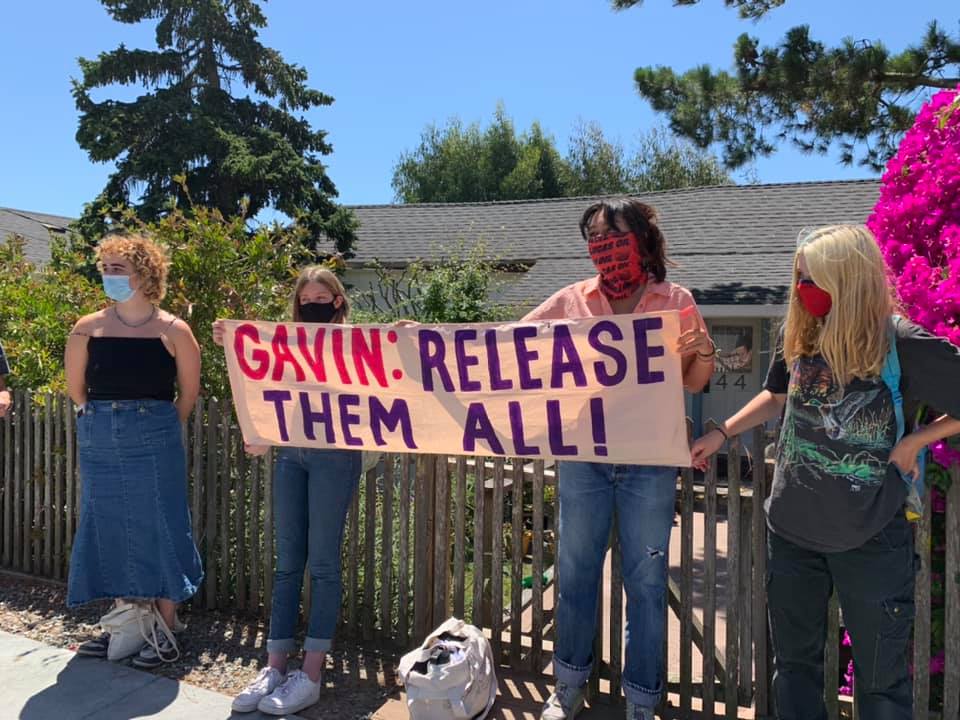
What really inspired me was that the families spoke without spite or rancor. They said they were not interested in blame, only in saving their loved ones from illness and death. My mentor Malcolm Feeley, who started the ball rolling on this by emailing me a couple of weeks ago saying “I’m so pissed”, said that this is the new victims’ rights movement: the victims of the state’s indifference.
Co-organizing the press conference was inspiring. There is no way a single organization or demographic could’ve put this thing together on their own. It took a diverse coalition of talent and experience, united by our passion to save people and put an end to what is probably the worst medical scandal in prison history. I am so grateful to my co-organizers–most of whom put an enormous amount of effort into this and stayed behind the scenes. They are an amazing group of people and I hope we can keep up the pressure on Gov. Newsom to do the right thing.
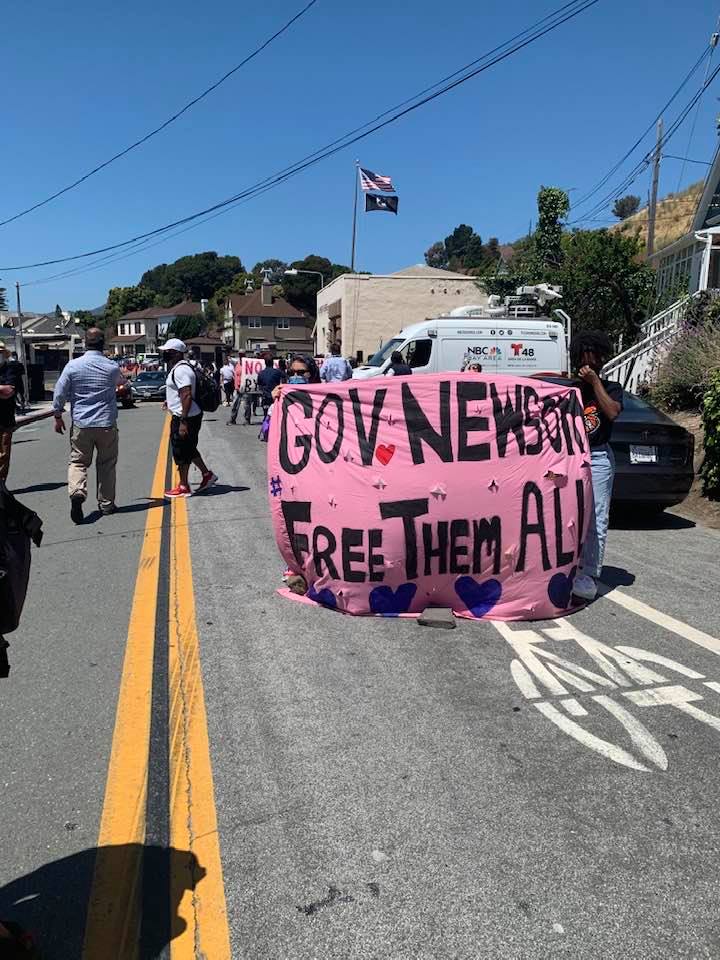
A few people asked me to post my speech, so here it is:
***
Hello. My name is Hadar Aviram and I am a law professor at UC Hastings. I am the author of an open letter to Governor Newsom asking him to release people from prison to save lives. I speak here on behalf of more than 400 of my colleagues [now closer to 500–H.A.], who signed the letter: criminal justice experts, prison law experts, public health experts. We are asking Gov. Newsom to do what he knows, in his heart of hearts, is the right thing.
An old Cherokee story tells of a wise grandfather and his grandson. The grandfather says, “Son, within each of us there is a battle between two wolves. One is evil. It is hatred, greed, arrogance, malice. The other is kind. It is compassion, love, empathy, and truth.” The grandson asks, “Which wolf wins?” The wise grandfather replies, “the one you feed.”
If Gov. Newsom were here, I would ask him which wolf he wants to feed. But he is not. Where is he? When people are getting sick and dying in droves, where is he? When buses transport people from prison to prison without testing and quarantining them, where is he? When people who test positive and negative are thrown together without care, where is he? When there is no retesting, where is he? When people get no medical treatment beyond checking their vitals, where is he? When people are terrified to report their symptoms out of fear that they will be thrown in death row or in solitary confinement, where is he? When we don’t even know what’s going on in jails and juvenile facilities because they are not reporting numbers, where is he?
I know that many people secretly think that lives behind bars are worth less than lives on the outside. Some of this ignorance comes from the panic and cabin fever of the pandemic. I would like to explain to them that prisons are part of the community, and that people in prison are members of the community. I should know; I ran the numbers. Infection rates in Marin county spiked after the outbreak in San Quentin. Infection rates in Lassen county spiked after the outbreak in prisons in Susanville. Saving lives in prison is a priority because it protects everyone, people behind bars and people on the outside. By contrast, incubating the virus in prisons endangers us all and makes all our prevention efforts futile. You asked us to do our part. When will you do your part, Gov. Newsom? Which wolf do you want to feed?
The people behind these gates are serving sentences under the California Penal Code. They were not sentenced to abuse, neglect, and illness. They were not sentenced to chaos and ineptitude. They are in the custody of their government, and with this great power comes great responsibility. So, Gov. Newsom, which wolf do you want to feed?
Newspapers have been making distinctions between so-called “violent” and “nonviolent” people. I am here to tell you the facts. The facts are that a quarter of the California prison population are people aged 50 and older. These people do not pose a risk to public safety; rather, they themselves face risks because of their age and deteriorating health. My colleagues and I have studied California crime rates for decades and found no correlation between the crime and commitment and the risk of reoffending. The public risk here is not from imaginary crime, but from the very real possibility that our prisons are turning into mass graves. So, Gov. Newsom, which wolf do you want to feed?
We’ve had to release people from our bloated prisons twice recently: in 2011 and in 2014. Both times, there was fearmongering, and there were stories in the media. We let out tens of thousands of people. We know what happened because we crunched the numbers: Crime rates stayed low. Violent crime did not rise. There was no increased risk to public safety. So, Gov. Newsom, which wolf do you want to feed?
The virus is tearing through Death Row, and the irony is that California has a moratorium on the death penalty. For decades, we litigated to the tune of billions of dollars how to kill people in a way that was not “cruel and unusual”. We were even careful to examine whether people were healthy enough to be killed by the state. And so, when you put the moratorium in place, Gov. Newsom, we applauded you for doing the right thing for California. How does that feel now, when more people have died during this moratorium than we actually executed in the entire century? Which wolf do you want to feed?
Moreover, we know for a fact that some of the people behind these gates, whom you are sentencing to death via Covid, are innocent. They are behind bars because of mistaken eyewitnesses, coerced confessions, and hidden exculpatory evidence. So, Gov. Newsom, which wolf do you want to feed?
And we know that crimes are not just a matter of choice. They come from a confluence of factors, such as poverty, neglect, deprivation, abuse, racial discrimination, persecution, food deserts, lead poisoning, necessity, mental illness, substance abuse, pain and hurt and suffering. The virus doesn’t take sides. The virus doesn’t decide who “deserves” to get sick. So, Gov. Newsom, which wolf do you want to feed?
In 2005, at the UC Berkeley ceremony in which I received my Ph.D., you, then Mayor of San Francisco, were the commencement speaker. You spoke of your decision to allow people to marry the person that they loved. And you said that it is important to do the right thing, even if it’s politically risky, even if you face press backlash, even if people are not ready for it. History has smiled on your bravery. We applauded you for your courage. Now is just such a moment. History is being written, right now, behind these gates. You know the right thing to do. Trust your own goodness. Trust your own courage. Trust your own compassion. Bring them home.
Feed the Right Wolf: Questions and Answers about the COVID-19 Crisis in Prison
I thought prisons were safe. How did the virus even get into prison? Because prisons in California are often in remote, rural areas, it’s easy to think of them as impermeable and far away, but that is not the case. In all prisons, staff members go in and out of the facility, and often live in the surrounding counties. This is how infections can permeate the prison from the community. But CDCR has also made some horrific decisions to transfer people between institutions without proper testing and quarantine protocols. These transfers are probably the source of the serious infection at San Quentin and the spread at Corcoran, as well as in Lassen County and other places. Recently, the medical officer of CDCR was ousted because of these instances of mismanagement.
Why is the virus spreading in prison? Almost all the prisons in California are overcrowded, some of them to the tune of 150% of their design capacity. Social distancing is difficult to do under these conditions. Some well-intentioned, but shortsighted, strategies we took to resolve this problem has just made prisons and jails more vulnerable to the virus. Staff circulate around the prison, as do workers who are incarcerated themselves; there are no solid protocols on cohorting these populations to prevent the spread.
Aren’t the sick people receiving free healthcare in prison? What people in prison receive is not “healthcare” as you understand it. It is appalling and neglectful, and often features weeks (sometimes months and years) of delays. Not too long ago, a person would die behind bars every six days from a preventable, and sometimes iatrogenic, disease. And, until recently, people paid copays for the “healthcare” they receive. The medical system was overwhelmed before the pandemic, despite desperate efforts to turn things around; overcrowding was, and still is (albeit to a lesser degree) still a complicating factor.
Aren’t the sick prisoners safer in prison, where they can be isolated from the rest of the community? No. By and large, prisons are doing a very poor job putting together social distancing protocols. COVID-19 is ravaging death row, where people are single-celled and you’d think would be protected from each other. And we are not safer if the virus is incubated in prisons, either. In at least two counties, Marin and Lassen, infections in the community spiked shortly after infections in prison spiked. Prisons are part of the community, and people in prison are members of the community. Staff go in and out of prison every day, sometimes multiple times a day. They live where you live; they eat where you eat; they shop where you shop. Keeping people in prison, where prevention and treatment are impossible, incubates the virus in prison, creating, essentially, a reservoir of illness to ravage the surrounding community.
Can’t we use solitary confinement to isolate sick people? No. Medical isolation and solitary confinement are two completely different things, as Cloud et al. explain in this article. Threatening people with solitary or death row celling terrifies them and disincentivizes people from reporting their symptoms and from getting tested. It is counterproductive and cruel.
But didn’t we already decide to release some people? So far, Gov. Newsom has only released 3,500 people, and is planning on 3,500 more. It is a mere drop in the bucket. We need to release tens of thousands of people to see improvement in the contagion. Remember that, following the 2011 Realignment, we released 40,000 people, are still wrestling with quality of healthcare, and that was without a pandemic going on.
Didn’t the Governor say that the prisoners don’t have anywhere to go? The Governor’s approach to this–to examine cases one by one for “worthiness” or “eligibility”–might have been a good fit three months ago. Now, we need to triage because we are facing a disaster on an enormous scale. Many people do have loving family members and friends who are happy to welcome them back to the community. Volunteers and advocates are at the ready to help with housing solutions.
If we release people, shouldn’t we prioritize nonviolent drug offenders over violent criminals? The distinction between so-called “nonviolent” and “violent” offenders doesn’t mean anything in terms of the risk they pose to the community. A quarter of the California prison population are people aged 50 and older. These people do not pose a risk to public safety, regardless of the crime they committed decades ago. At this point, “prioritizing” is no longer a luxury we have. We must let people out in large numbers to contain the virus and prevent the prison from turning into a mass grave.
If we release criminals into the streets, won’t that endanger public safety? No. We did large-scale releases before, in 2011 and in 2014, and crime rates, particularly violent crimes, did not go up. If we see an uptick in crime in the following months, it will likely be the natural outcome of the relaxed pandemic prevention restrictions, and will not reflect people released from prison. When you see newspaper articles
Aren’t people on death row going to die anyway? No. California has a moratorium on the death penalty. And before the moratorium (and even now, because the death penalty is still in the book), we have litigated for decades, to the tune of billions of dollars, how to appropriately and constitutionally execute people. We were even careful, absurdity of absurdities, to examine whether people were healthy enough to be killed by the state. We have not made this effort and spent this money so that people could die via COVID-19. Also, keep in mind that a proportion of these people are innocent of the crimes they were sentenced to death for.
We have limited resources, and I’d rather spend them on deserving people than on people who committed violent crime. It is true that we have limited resources, and because of that, they must be spent where they can help us prevent contagion, illness, and death. COVID-19 is not a zero-sum game; it’s not like there’s an allotted number of sicknesses and you get to decide who deserves or does not deserve to get sick. Prisons are not separate from the community; they are part of the community. Allowing the contagion to ravage prisons incubates the disease within the prisons and poses a risk to all of us. If people in prison get sick, people outside of prison get sick, including you and your loved ones. It is an urgent priority to spend the resources where they can prevent illness and death for all of us.
I don’t care about people in prison. You do the crime, you do the time. The people serving prison sentences in California were sentenced under the California Penal Code. The Penal Code does not sentence people to neglect, abuse, contagion, illness, and death. Moreover, many of the people serving time in prison, and even on death row, are factually innocent. But more profoundly, ask yourself what role your lack of compassion for fellow human beings is playing in your life. A Cherokee story tells of a wise grandfather and his grandson. The grandfather says, “Son, within each of us there is a battle between two wolves. One is evil. It is anger, envy, jealousy, sorrow, regret, greed, arrogance, self-pity, guilt, resentment, inferiority, lies, false pride, superiority, and ego. The other is good. It is joy, peace, love, hope, serenity, humility, kindness, benevolence, empathy, generosity, truth, compassion, and faith.” The grandson asks, “Which wolf wins?” The wise grandfather replies, “the one you feed.”
The “What’s In It For Me?” Angle on COVID-19 Prison Releases
The thing everyone was warning you about has happened: the prisons, incubators of COVID-19, are spreading it to the general population. The Columbus Dispatch, reporting on the Ohio prisons rife with infections and disease, reports:
Marion County’s top health official is urging vigilance as the outbreak of the novel coronavirus in a Marion prison spills into the community.
More than 80% of Marion Correctional Institution’s inmates have tested positive for the coronavirus, as have more than 160 corrections officers and other employees, according to the Ohio Department of Rehabilitation and Correction. Those workers live in Marion County and surrounding counties.
More prisoners might have the virus because although a prison spokesperson previously said that mass testing was completed more than a week ago, spokesperson JoEllen Smith said Friday that only 2,300 tests had been administered. She did not clarify whether that included employees, and the prison has about 2,500 inmates.
Even excluding the prisoners who have tested positive, Marion County has a higher number of cases per capita than almost every other county in Ohio, including densely populated ones such as Franklin and Cuyahoga, according to Ohio Department of Health data.
[Health commissioner Traci] Kinsler attributed Marion County’s high number of cases per capita to the prison outbreak.
The idea of prisons as incubators of miasma is as old as the prison reforms of John Howard. Ashley Rubin has a terrific thread on this on Twitter. As she explains, preventing the spread of disease was at the forefront of the reformers’ interests, and for many thinkers was a metaphor for the spread of crime.
Many of the campaigns for releasing prisoners that I’ve seen make the scientifically correct point that, as long as U.S. prisons remain Petri dishes for the virus, nobody’s safe. I want to draw an important distinction between this argument and the equally correct argument that prisoners–better said, people who happen to be in prison during this outbreak–are human beings, too, whose protection from the virus would have to be a priority from a human rights perspective whether or not they endangered others.
I’m wondering whether the former argument is made not only because it is sound (it is) but because of realpolitik. In Cheap on Crime I argued that the post-recession reforms a-la “justice reinvestment”, which led to a decline in the overall U.S. prison population for the first time in 37 years, benefitted from having a morally neutral cost argument, which allowed activists and advocates to break the decades-long impasse between public safety and human rights. It’s quite possible that framing prisoner release as a “what’s in it for me?” argument, rather than an argument on behalf of the prisoners themselves, has more persuasive power, and if so, I’m all for whichever argument gets less people, in and out of prison, sick or dead.
But just so that we get a glimpse of life behind bars, here are some words from Kevin Cooper, an innocent person on San Quentin’s death row (shared with me via email through Innocence Project):
Experiencing COVID-19 on Death Row
By Kevin Cooper
In my humble opinion being on death row with this COVID-19 pandemic raging is like having another death sentence. I can and do only speak for myself in this essay, and I must admit that I am scared of this virus!
I pride myself on not being scared of anything or anyone on death row, not even death itself, because after all this is death row. But this virus is more than just dying, or death. It’s a torturous death, like lethal injection is.
I do all I can to take care of me in here under these traumatic times and stressful circumstances. I social distance, I wash my hands regularly, clean this cage that I am forced to live in on a regular basis, and I often ask myself is this enough?
Every inmate who lives next to me or around me to my knowledge is taking care of themselves too. Quite a few still go outside to the yard every other day as we are allowed to do. I went out for the first time two days ago after a month living non-stop inside this cage. I went out to get fresh air.
This unit, East Block, has staff who have been giving us cleaning supplies such as “cell block” which is a strong liquid cleaning agent, and we use that to spray on a towel and wipe the telephone down before each inmate uses the phone. We have been given hand sanitizer for the first time since this pandemic started. It’s a 6-ounce bottle and the writing on it says World Health Organization Formula. The same World Health Organization that Trump just stopped funding…no joke!
We still have not received any mask* though a memo was sent around last week stating that cloth masks were being made to be passed out to inmates but that they have not yet been finished being made. Who is making them? I don’t know.
We people, we human beings on death row aren’t for the most part cared about by society as a whole. That truth makes some of us wonder, including me, do the powers that be truly give a damn whether we human beings who have been sentenced to death by society care if any of us get the coronavirus and die from it in a tortuous way?
In 2004 I came within 3 hours and 42 minutes of being tortured and murdered/executed by the state of California. I survived that, and have worked very hard with lots of great people to prove that I am innocent, that I was framed by the police and that I am wrongfully convicted. To do all of this and, especially to survive that inhumane and manmade ritual of death in 2004, only to be taken out by COVID-19 is something that honestly goes through my mind on a regular basis. Right now, I am free of this virus and I am doing everything to stay this way. But that thought, that real life and death thought of the coronavirus taking my life is always present, especially under these inhumane manmade prison conditions on Death Row.
*On Monday, April 20th, Kevin called to say: I received a cloth face mask today as did everyone here on death row. We are now instructed to use it every time we leave the cell.
Cause of Death
 |
| Source here. |
Today I came across this sobering table, which struck me as important not only for the obvious reasons. You’ll note that homicide is nowhere in the top-ten list of causes of death for Americans. If you look at the CDC reports for causes of death in 2017 based on vital statistics, you’ll see homicide ranked anywhere between #106-108 (interestingly, “legal intervention” is ranked 109.)
Yet, to browse through the list of Netflix and Prime Video shows we are offered to numb our souls from the pandemic experience, you could be mistaken to believe that a much higher proportion of Americans succumb to homicide. And to me, this suggests that the current debate about who to release on the basis of “public safety” is guided more by folk devils than by real concerns.
Assuming that you include people in prison in the overall category of human beings whose lives and health matter (if you don’t, thank you for reading this far–we probably don’t speak the same language and I hold no hope of convincing you, nor should you hope to convince me), it should be obvious that COVID-19 poses a much greater risk to public safety, broadly defined, than homicide.
Now, releasing people convicted of violent crimes is not really a trade-off between COVID-19 deaths and homicide deaths, given that the folks most at risk healthwise, as I explained yesterday, are old and sick and also happen to have committed violent crime decades ago.
So, if there is reluctance to release the folks colloquially known as “violent offenders”–many of whom would barely have a technical write-up or two for the last two or three decades–it’s not really coming from concerns for public safety, is it? It’s coming from concerns for palatability and an idea that this is the right time for abstract ideas for retribution.
If I put the state’s resistance to do the right thing here together with the mismanagement of homeless populations, it almost seems like, at our time of need, we’ve simply decided that the bottom rung or two in the American class ladder don’t matter. And they do, which makes my heart hurt.
In Tricycle Magazine, Chenxing Han writes so beautifully:
The Buddha is often likened to a physician. He diagnosed the unsatisfactoriness of the human condition and revealed its cause. The Buddha was no doomsayer, however: his teachings were treatments that promised a cure, an ultimate freedom from that which ails us. SARS-CoV-2 is a truth-teaching virus. It has revealed to me a deep well of fear: of my loved ones dying, of dying myself (or, during more mundane moments, of running out of brown rice). More incisively, it has revealed society’s disturbing inequities and gross iniquities, forcing us to confront the truth of how the most vulnerable among us—the poor, the disabled, the unhoused, and the otherwise marginalized—bear the brunt of this crisis.
What this cruel teacher will teach our state about caring for its most vulnerable wards remains to be seen–hopefully before it is too late.
Yes, We *Have* to Release People Originally Convicted of Violent Crime: The Last Hearing of Susan Atkins
| Susan Atkins wheeled into her last parole hearing in 2009, accompanied by her husband, James Whitehouse. Photo credit: Ben Margot for the Associated Press. |
Latest news on prisoner release: A couple of days ago, the three-judge Plata panel denied relief for procedural reasons (TL;DR “we are not the appropriate forum for this – go to the original courts.”) As good people are scrambling to put together writs for those courts, I wanted to address something that I *thought* would be obvious, but apparently isn’t.
In the aftermath of putting up my petition to release prisoners, I’ve been hearing commentary that we should limit the releases to “nonviolent criminals.” I use the quotation marks because the definitions of what is and is not “violent” and “nonviolent” is not as clear as people think, and because someone’s crime of commitment is not necessarily an indication of their violent tendencies at present, nor does it predict their recidivism.
In Cheap on Crime and elsewhere I described the post-recession efforts to shrink prison population, which targeted only nonviolent people; reformers understandably thought that such reforms would be more palatable to the public. The problem with this kind of policy, though–as this excellent Prison Policy report explains–is that these kind of reforms ignore the majority of people in prison, who happen to be doing time for violent crime.
In addition to this, if we are looking at releases to address a public health crisis, we have to release the people who are vulnerable to the public health threat. And who, in prison, is most vulnerable? Aging and infirm prisoners.
The math is simple. Out of the prison population, folks who were sentenced for a violent crime are the ones most likely to be (1) aging and (2) infirm. Aging, because the sentences are much longer; and infirm, because spending decades in a hotbed of contagion, with poor food and poor exercise options, does not improve one’s health. We know that a considerable portion of the health crisis in California prison is iatrogenic; not so long ago, Supreme Court Justices were horrified to learn that a person was dying behind bars every six days fo a preventable disease. So, a person who has spent decades in prison is more likely to be vulnerable to health threats. Such a person is also more likely to be older (by virtue of having been in prison for 20, 30, 40 years!) and therefore far less of a public risk of reoffending than a younger person who’s been inside for a few months for some nonviolent offense.
So, if there’s any reluctance to release people who are (1) old, (2) sick, and (3) more likely to contract a serious form of disease that will (4) cause more suffering and (5) cost more money, it’s time to look in the mirror and ask ourselves – why?
Is it really because of a mission to protect the public? Because old, sick people are not a safety risk to the public.
So, is it perhaps because we think of these releases not as an essential public health action, but as some kind of “reward” for people who we think are “worthy” or “deserving”?
The correctional system’s ignorance of old age and sickness is a topic I know something about. In Chapter 6 of my book Yesterday’s Monsters I describe the 2009 parole hearing for Susan Atkins, one of the Manson Family members who participated in the murder of Sharon Tate and her friends in 1969. Forty years later, in her early sixties and ravaged by an inoperable brain tumor, Atkins–a devout Christian with a clean disciplinary record for decades–was wheeled into her hearing on a gurney. At her side was her 17-year husband, lawyer James Whitehouse, who represented her in the hope that she be allowed to spend the last few months of her life by his side.
The Parole Commissioners’ treatment of the case was shockingly obtuse. They started by offering the barely conscious Atkins a hearing aid (as if she could hear them), analyzed old psychological reports from her file, and addressed her educational and rehabilitation “prospect.” They even mocked her husband for being able to afford palliative care for his wife. Incensed by this facetiousness, Whitehouse exploded:
For the record, she’s lying in her gurney here. She is paralyzed over 85 percent of her body. She can move her head up and down. She can move it to the side. She used to have partial use of her left arm, partial limited use, meaning she can’t wave to you. She can’t give you a thumbs up. She no longer can point at you, I believe. She can’t snap her fingers. And this is the evidence. . . . We haven’t been able to get her in a wheelchair for well over a year. Permanent speech impairment—“does not communicate, speaking or writing”—complex medical needs, assistance needed eating, bathing, grooming, moving, cleaning, permanent speech and comprehension impairment due to underlying medical problems. . . . That’s the only evidence regarding her medical condition. And all those things have to do with what we are supposed to be looking for the future of behavior. In light of that, is there anything that her commitment offense has to do that’s probative to what she’s going to be doing in the future as far as you know? That’s a question.
The Parole Board refused to release Atkins, arguing that “these Manson killings and the rampage that went on is almost iconic and they have the ability to influence many other people, and she still has that ability as part of that group.” Atkins, who had no ability to do anything at all, died alone in prison a few months later.
If this outcome feels okay to you, ask yourself: what’s it to you? Do you have an idea of deservedness, of a price to pay, of just deserts? Do you think your idea of an appropriate time spent behind bars bows to no one, to nothing, not even to old age, sickness, and death?
Do you feel comfortable sentencing thousands of California prisoners to death because of these ideas of deservedness, or appropriate retribution, that you have? Will these ideas give you comfort when CDCR has to reckon with thousands of preventable deaths of human beings, just like you?
And if your answer is, “well, they didn’t consider that when they killed their victims, right?”, I have news for you: The victims are not coming back. They’ve been gone for decades. It’s horrible, and tragic, and we can’t fix that. Certainly not with another tragedy.
Get in touch with our common humanity. Write to the Governor. Sign my petition. Do something.
Gov. Newsom, Please Release More Prisoners to Prevent CDCR from Becoming a Mass Grave
Dear Gov. Newsom,
Many thanks for your tireless work on behalf of Californians in their hour of need. I can only imagine the multiple emergencies on your agenda and the many proverbial fires you must put out to “flatten the curve” and give our emergency services a fighting chance against the COVID-19 pandemic.
I appreciated learning about your recent commutations, as well as about the plans you have put in place to release 3,500 prisoners from CDCR custody. It is a good start, but, unfortunately, it will likely be merely a drop in the bucket.
Less than a decade ago, the Supreme Court found healthcare conditions at CDCR so appalling that, every six days, a person behind bars died from a preventable, iatrogenic disease. The Court attributed this massive failure to deliver anything that could be even remotely called “health care” to overcrowding in prisons, and supported the federal three-judge panel recommendation to release approximately 30,000 prisoners. That has somewhat improved the situation, but even with massive efforts toward a turnaround on the part of the federal receiver, we are still seeing woefully deficient healthcare–interminable lines and wait times, people treated in cages in which they have to wait for hours, “group therapy” consisting of a semicircle of cages.
And that’s without a pandemic going on.
Gov. Newsom, our prisons are a Petri dish for contagion and disease. It is impossible to provide minimal health care to this many people with a highly contagious virus on the loose.
The Public Policy Institute of California, relying on CDCR statistics, reports that 23% of California inmates are 50 or older. Aging prisoners may be contributing to California’s prison health care costs—now highest in the nation. The state spent $19,796 per inmate on health care in fiscal year 2015, according to the Pew Charitable Trusts. These costs were more than three times the national average and 25% more than in 2010. Moreover, many California prisoners serve extremely long sentences: Approximately 33,000 inmates are serving sentences of life or life without parole. Another 7,000 are “third strikers,” fewer than 100 of whom are released annually after serving about 17 years. Fewer than 1,000 of these inmates are released every year, typically after spending two or more decades behind bars.
Isn’t decades in prison enough? How much retribution or deterrence do we still need for people serving sentences of 30, 40, or 50 years, that we must keep them behind bars for longer in the face of a lethal pandemic?
Robust research about aging in prison confirms that people age much faster behind bars than they do on the outside, and they are much more vulnerable to disease–partly because of confinement conditions and partly due to faulty health care.
The scale of releases we should contemplate is in the tens of thousands, not in the thousands. If you do not act now, within a few short weeks, the CDCR will become a mass grave.
Please, don’t let the current litigation be the only push to do the right thing. You have done the right thing so many times–as Mayor of San Francisco and as our Governor. The prisoners are Californians, too. They can’t vote from prison, but they are your constituents and you must consider their welfare.
Please, act now, before thousands of lives are lost.
Readers, please join this open letter by signing my Change.org petition.
Body-Worn Cameras in Prison?
 Aili Malm and Mike White have a wonderful new book out about body-worn cameras for police officers. They review the scientific evidence we have on the impact of body-worn cameras on policing quality, use of force by and against the police, behavior toward the police, complaints (true and false), etc., and offer some helpful policy guidelines for how to regulate the use of cameras. The thorniest issue, I think, is how the footage gets used. Prisons would require careful regulation of the footage use and access to it–even more so than in the police context, because the access to technology to see, let alone use, the footage is so asymmetric. But that something is difficult doesn’t mean it should not be done. If it’s something that is likely to improve behavior in prisons and prevent violence and abuse, it should be in everyone’s benefit to implement it.
Aili Malm and Mike White have a wonderful new book out about body-worn cameras for police officers. They review the scientific evidence we have on the impact of body-worn cameras on policing quality, use of force by and against the police, behavior toward the police, complaints (true and false), etc., and offer some helpful policy guidelines for how to regulate the use of cameras. The thorniest issue, I think, is how the footage gets used. Prisons would require careful regulation of the footage use and access to it–even more so than in the police context, because the access to technology to see, let alone use, the footage is so asymmetric. But that something is difficult doesn’t mean it should not be done. If it’s something that is likely to improve behavior in prisons and prevent violence and abuse, it should be in everyone’s benefit to implement it. 

